Credibility Assessment Toolkit
> Joycevalenza
Fact Checkers Collection
Balanced news, issues and opinions, media bias ratings, political news. *Check, Please! Starter Course: Caulfield. *Civic Online Reasoning. If young people are not prepared to critically evaluate the information that bombards them online, they are apt to be duped by false claims and misleading arguments. To help teachers address these critical skills, we’ve developed assessments of civic online reasoning—the ability to judge the credibility of digital information about social and political issues. These assessments ask students to reason about online content. We’ve designed paper-and-pencil tasks as well as tasks that students complete online.
These assessments are intended for flexible classroom use. We hope teachers use the tasks to design classroom activities, as the basis for discussions about digital content, and as formative assessments to learn more about students’ progress as they learn to evaluate online information. As part of MediaWise, the Stanford History Education Group is developing and evaluating new civic online reasoning lesson plans for middle and high school students.
MediaWise: How to sort fact from fiction online. Civic Online Reasoning Classroom Poster. SHEG: Intro to Lateral Reading. Civic Online Reasoning. Civic Online Reasoning in Action. How to Find Better Information Online: Click Restraint. *DigiPo4 Moves Infographic. *SIFT (The Four Moves)
So if long lists of things to think about only make things worse, how do we get better at sorting truth from fiction and everything in-between?
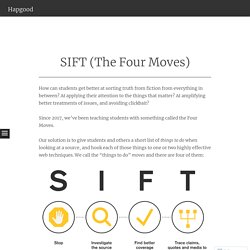
Our solution is to give students and others a short list of things to do when looking at a source, and hook each of those things to one or two highly effective web techniques. We call the “things to do” moves and there are four of them: Stop The first move is the simplest.
*The News Literacy Project. Mind Over Media: (Renee Hobbs, URI)
Isn't it time to stop Wikipedia shaming? - NeverEndingSearch. I am currently working on a research project with partners from the University of Florida and OCLC.

Researching Students’ Information Choices (RSIC), our IMLS-funded study, uses simulated Google result lists to examine what happens when student researchers make real-time search engine result page decisions. I thought I’d share some of our preliminary findings. This post looks at a progression of student thinking (and questioning) about the value of Wikipedia as they move across educational stages. Our study examined the behaviors and choices of 175 student participants, across six educational stages, as they engaged in four tasks in response to a grade-appropriate science research prompt.
SHEG: How to use Wikipedia Wisely. WHO: How to protect yourself in this infodemic.
WHO: Let’s flatten the infodemic curve. We are all being exposed to a huge amount of COVID-19 information on a daily basis, and not all of it is reliable.
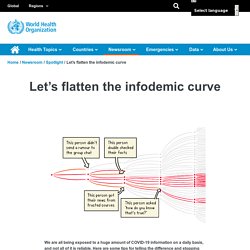
Here are some tips for telling the difference and stopping the spread of misinformation. Due to COVID-19, most of us have a new word in our vocabulary: epidemiology. It is the branch of medical science that deals with the ways diseases are transmitted and can be controlled in a population. Now it is time to learn another new word: infodemiology. As humans, we are a curious and innovative species. But it is not only scientific studies.
7 Questions Every Student Should Ask. A Field Guide to “Fake News” and Other Information Disorders.
A Rough Guide to Spotting Bad Science. A Rough Guide to Spotting Bad Science Click to enlarge A brief detour from chemistry, branching out into science in general today.
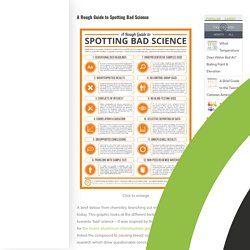
This graphic looks at the different factors that can contribute towards ‘bad’ science – it was inspired by the research I carried out for the recent aluminium chlorohydrate graphic, where many articles linked the compound to causing breast cancer, referencing scientific research which drew questionable conclusions from their results. The vast majority of people will get their science news from online news site articles, and rarely delve into the research that the article is based on. Personally, I think it’s therefore important that people are capable of spotting bad scientific methods, or realising when articles are being economical with the conclusions drawn from research, and that’s what this graphic aims to do.
Digital & Media Literacy (MediaSmarts)
A Rough Guide to Types of Scientific Evidence. Click to enlarge Today’s graphic looks at science in general, rather than just chemistry.
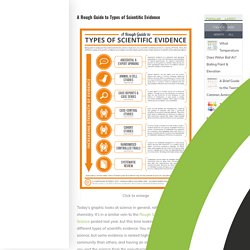
It’s in a similar vein to the Rough Guide to Spotting Bad Science posted last year, but this time looking at the hierarchy of different types of scientific evidence. You might think science is science, but some evidence is ranked higher in the scientific community than others, and having an awareness of this can help you sort the science from the pseudoscience when it comes to various internet claims. This graphic was inspired by a couple of things this week.
An index of unreliable news websites. The lists we combined to create the index had 1,043 unique domain names.

Of these, as of November 2018, 515 were still active and another 528 were inactive (51 percent) — either no longer online or no longer posting stories. We detected inactive sites programmatically by retrieving HTTP status codes (404s or 301s), using auto-generated screenshots and, in some cases, by visual inspection. We curated the resulting list, trimming it a bit, by removing several sites whose stories, though highly politicized, were mostly not fake: alternet.org, cato.org, heritage.org, nationalreview.com, thedailybeast.com, theintercept.com, thinkprogress.org, and weeklystandard.com.
Beyond Fake News. Common Sense Media: News and Media Literacy Resource Center.
Checkology® Virtual Classroom. Register now!
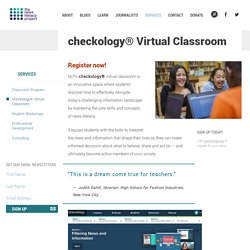
NLP’s checkology® virtual classroom is an innovative space where students discover how to effectively navigate today's challenging information landscape by mastering the core skills and concepts of news literacy. It equips students with the tools to interpret the news and information that shape their lives so they can make informed decisions about what to believe, share and act on — and ultimately become active members of civic society.
This is a dream come true for teachers. Judith Dahill, librarian, High School for Fashion Industries, New York City. Choose Your News: A Media Literacy HyperDoc - Google Slides. CML E-Commerce Web Site - Curricula, Lessons, Activities, Assessment. Crash Course: Navigating Digital Information. Connected Society: media literacy discussion cards. CRAAP Test. Craig Silverman (craigsilverman) on BuzzFeed. Current events analysis. Curriculum_Materials. Curriculum_Materials. DataJournalism.com. Digital Forensics Resources Master List:
EdCan Network Facts on Education Fake News 1. Web Literacy for Student Fact-Checkers. Evaluating news sources is one of the more contentious issues out there.
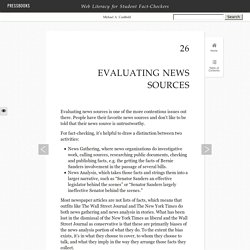
People have their favorite news sources and don’t like to be told that their news source is untrustworthy. For fact-checking, it’s helpful to draw a distinction between two activities: News Gathering, where news organizations do investigative work, calling sources, researching public documents, checking and publishing facts, e.g. the getting the facts of Bernie Sanders involvement in the passage of several bills.News Analysis, which takes those facts and strings them into a larger narrative, such as “Senator Sanders an effective legislator behind the scenes” or “Senator Sanders largely ineffective Senator behind the scenes.” Most newspaper articles are not lists of facts, which means that outfits like The Wall Street Journal and The New York Times do both news gathering and news analysis in stories.
Narratives are a different matter.
Evaluative, Annotated Works Cited. Facebook Ad Library. Facing Facts: An Inside Look At Facebook's Fight Against Misinformation. Factitious. Fake Collections - The Veronica Butcher Fake Sources Collection - Gould Guides at Carleton College. Fake News - Fake News & Fact Checking - Research Guides at Sonoma State University. 1.
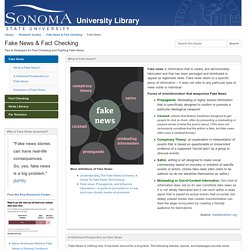
It can't be verified A fake news article may or may not have links in it tracing its sources; if it dos, these links may not lead to articles outside of the site's domain or may not contain information pertinent to the article topic. 2.
Fake News - LibGuides at William Paterson University. Fake News Historical Timeline (Common Sense Education)
Fake News, Alternative Facts and Librarians As Dedicated Defenders of Truth. Let's be clear, there's no such thing as "alternative facts.
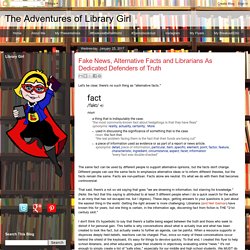
" The same fact can be used by different people to support alternative opinions, but the facts don't change. Different people can use the same facts to emphasize alternative ideas or to inform different theories, but the facts remain the same.
Fake News: How A Partying Macedonian Teen Earns Thousands Publishing Lies. Fauxtography Archives - Snopes.com. Fight The Fake: Get the what-why-and-how resource list. Today’s students must learn to filter through the excess of information to find the facts, which is often easier said than done.
First Draft News. These sources have minimal bias and use very few loaded words (wording that attempts to influence an audience by using appeal to emotion or stereotypes).
The reporting is factual and usually sourced. These are the most credible media sources. See all Least Biased Sources.
First Draft News: Education. Five Editor-Approved Tips for Media Literacy in Any Class. In 2015, a year before murmurs of “fake news” became omnipresent, textbook publisher McGraw-Hill was under fire for a World Geography book illustration. The section, on patterns of immigration throughout American history, referred to a wave of “immigration” in which African “workers” arrived in the United States. Parents, students and teachers were outraged by the sugarcoated and outright false history of slavery being shared in classrooms across Texas. This was one incident of false information making its way into schools, but it was far from the first or last. Clickbait headlines and polarizing politics have made it a daunting challenge for teachers to find factual, reliable information inside and outside of the classroom.
A class needs to share a foundation of truth. Fact-checking and looking for bias are no longer just skills needed in journalism class or at the school paper.
FOG Analysis. Get Your Own 'Is This Story Share-Worthy?' Poster - NewseumED. Global Media Manipulation Case Book. Google News Lab. Help Students Spot Student Fake News. In the executive summary, released on November 22, 2016, the researchers stated: "When thousands of students respond to dozens of tasks there are endless variations. That was certainly the case in our experience. However, at each level—middle school, high school, and college—these variations paled in comparison to a stunning and dismaying consistency.
Overall, young people’s ability to reason about the information on the Internet can be summed up in one word: bleak.
"
How false news can spread - Noah Tavlin. How to outsmart fake news in your Facebook feed - CNN.
How to Spot Fake News - FactCheck.org. How to Spot Responsible Journalism and the Fake News Frenzy. How to Teach Media Literacy in a Virtual Classroom. How To Spot Fake News. Informable Digital. Information Disorder: The Definitional Toolbox. Over the past eighteen months, issues of trust and truth in the digital age have dominated discussion across industries and around the world. There has been a surge in conferences, reports and funding. However, despite this peak in interest in the subject, progress has been slow. One important realization yet to emerge is that shared definitions and terminology matter.
For the policy-makers, technology companies, politicians, journalists, librarians, educators, academics and civil society organizations all wrestling with the challenges caused by false and misleading information, agreeing upon a shared vocabulary is essential.
Interactive Media Bias Chart – 2 – Ad Fontes Media. International Fact-Checking Network - Poynter. Is This Story Share-Worthy? Flowchart. Kathy Schrock's 5Ws of Web Evaluation.
Lead Stories. Learn to Discern: Media Literacy Trainer's Manual. People are flooded with misinformation, disinformation, manipulative content, and junk information that drown out credible information.
Media Literacy Clearinghouse. Mind Over Media: Analyzing Contemporary Propaganda (URI)
This web platform provides an opportunity to explore the subject of contemporary propaganda by hosting thousands of examples of 21st century propaganda from around the world. Users can upload, examine and discuss examples of propaganda from our own daily lives.
News & Media Literacy. News Lit Quiz — News Literacy Project. News Literacy - High School. The universe of information we live in is a complicated web of messages with a mind-blowing array of sources, biases, and agendas.
NEWS LITERACY FOR VIRTUAL PROTESTERS by Elaine Levia. News literacy rules of thumb. News literacy vocabulary to introduce in talking about credibility. News Quality Chart. News Use Across Social Media Platforms 2017. NoodleTools : Show Me Information Literacy Modules. Not all scientific studies are created equal - David H.
On student scrutiny: two strategies. Persuasive Maps. Politicalcartoons.com - Cartoons. Politifact: Fact-checking U.S. politics. Project Look Sharp. RADAR Framework - Evaluating Sources: Using the RADAR Framework - LibGuides at Loyola Marymount University. Rate My Sources uwgreenbay.qualtrics. Red Bank Public Library: Fake News Rsources. SEEING ISN’T BELIEVING The Fact Checker’s guide to manipulated video (Washington Post)
Sifting Through the Pandemic – Information hygiene for the Covid-19 infodemic. Society of Professional Journalists Code of Ethics. The Cardigan Papers – American history and news literacy meet in the school library,
Stony Brook Center for News Literacy Course-Pack. The Problem with Fake News (and how our students can solve it)










